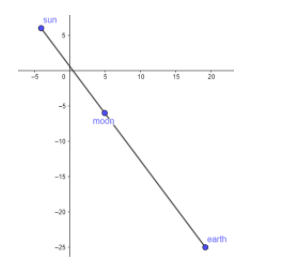
In the diagram on a lunar eclipse, if the position of sun, earth, moon are shown by $\left( -4,6 \right),\left( k,-25 \right),\left( 5,-6 \right)$ respectively then find the value of k.
Answer
584.1k+ views
Hint: Here, first we should know that in a lunar eclipse, all the three that are sun, earth and moon come in straight line. So, using this logic we have to identify that all the three given points are collinear. After this we use the determinant formula equating it with zero. i.e. $\dfrac{1}{2}\left| \begin{matrix}
{{x}_{1}}-{{x}_{2}} & {{x}_{2}}-{{x}_{3}} \\
{{y}_{1}}-{{y}_{2}} & {{y}_{2}}-{{y}_{3}} \\
\end{matrix} \right|=0$ which is also used to find the area of the triangle when points are lying on vertices.
So, using this formula, we will get the value of K.
Complete step-by-step answer:
Here, we are given three coordinate points i.e. $\left( {{x}_{1}},{{y}_{1}} \right),\left( {{x}_{2}},{{y}_{2}} \right),\left( {{x}_{3}},{{y}_{3}} \right)$ which is $\left( -4,6 \right),\left( k,-25 \right),\left( 5,-6 \right)$ .
We also know that in lunar eclipse, earth comes between sun and mood. So, all the three i.e. sun, earth and moon come in straight line. So, here we can consider that all the three points are in a straight line which is known as collinear points.
So, here we can use the coordinates $\left( {{x}_{1}},{{y}_{1}} \right),\left( {{x}_{2}},{{y}_{2}} \right),\left( {{x}_{3}},{{y}_{3}} \right)$ as the vertices of triangle and find the area of it equating it with zero. Using the formula
$\dfrac{1}{2}\left| \begin{matrix}
{{x}_{1}}-{{x}_{2}} & {{x}_{2}}-{{x}_{3}} \\
{{y}_{1}}-{{y}_{2}} & {{y}_{2}}-{{y}_{3}} \\
\end{matrix} \right|=0$
So, substituting the values in the above formula, we get as:
$\dfrac{1}{2}\left| \begin{matrix}
-4-k & k-5 \\
6-\left( -25 \right) & -25-\left( -6 \right) \\
\end{matrix} \right|=0$
$\Rightarrow \dfrac{1}{2}\left| \begin{matrix}
-4-k & k-5 \\
6+25 & -25+6 \\
\end{matrix} \right|=0$
Now, multiplying the determinant we get,
$\Rightarrow \dfrac{1}{2}\left( \left( -4-k \right)\left( -19 \right)-31\left( k-5 \right) \right)=0$
$\Rightarrow \dfrac{1}{2}\left( 76+19k-31k+155 \right)=0$
On further simplification, we get
$\Rightarrow \dfrac{1}{2}\left( 231-12k \right)=0$
On multiplying both sided by 2 we get,
$\Rightarrow 231-12k=0$
Taking constant on one side and variable on other side, we get
$\Rightarrow 231=12k\Rightarrow k=\dfrac{231}{12}=19.25$
Graph representation is shown below.

All are in a straight line.
Thus, the value of k will be 19.25.
Note: Another approach for solving this problem is using the slope method for coordinate points $\left( -4,6 \right),\left( k,-25 \right),\left( 5,-6 \right)$ . So, we will use the formula as $slope=\dfrac{{{y}_{2}}-{{y}_{1}}}{{{x}_{2}}-{{x}_{1}}}$ or $slope=\dfrac{{{y}_{1}}-{{y}_{2}}}{{{x}_{1}}-{{x}_{2}}}$ . Here, we have three points so, using this formula we get as
$slope=\dfrac{{{y}_{1}}-{{y}_{2}}}{{{x}_{1}}-{{x}_{2}}}=\dfrac{{{y}_{2}}-{{y}_{3}}}{{{x}_{2}}-{{x}_{3}}}$
On further solving, we get
$=\dfrac{6+25}{-4-k}=\dfrac{-25+6}{k-5}$
$=31\left( k-5 \right)=\left( -19 \right)\left( -4-k \right)$
$=31k-155=76+19k$
Thus, on solving we get $12k=231\Rightarrow k=\dfrac{231}{12}=19.25$ .
So, using this method we get the same answer.
{{x}_{1}}-{{x}_{2}} & {{x}_{2}}-{{x}_{3}} \\
{{y}_{1}}-{{y}_{2}} & {{y}_{2}}-{{y}_{3}} \\
\end{matrix} \right|=0$ which is also used to find the area of the triangle when points are lying on vertices.
So, using this formula, we will get the value of K.
Complete step-by-step answer:
Here, we are given three coordinate points i.e. $\left( {{x}_{1}},{{y}_{1}} \right),\left( {{x}_{2}},{{y}_{2}} \right),\left( {{x}_{3}},{{y}_{3}} \right)$ which is $\left( -4,6 \right),\left( k,-25 \right),\left( 5,-6 \right)$ .
We also know that in lunar eclipse, earth comes between sun and mood. So, all the three i.e. sun, earth and moon come in straight line. So, here we can consider that all the three points are in a straight line which is known as collinear points.
So, here we can use the coordinates $\left( {{x}_{1}},{{y}_{1}} \right),\left( {{x}_{2}},{{y}_{2}} \right),\left( {{x}_{3}},{{y}_{3}} \right)$ as the vertices of triangle and find the area of it equating it with zero. Using the formula
$\dfrac{1}{2}\left| \begin{matrix}
{{x}_{1}}-{{x}_{2}} & {{x}_{2}}-{{x}_{3}} \\
{{y}_{1}}-{{y}_{2}} & {{y}_{2}}-{{y}_{3}} \\
\end{matrix} \right|=0$
So, substituting the values in the above formula, we get as:
$\dfrac{1}{2}\left| \begin{matrix}
-4-k & k-5 \\
6-\left( -25 \right) & -25-\left( -6 \right) \\
\end{matrix} \right|=0$
$\Rightarrow \dfrac{1}{2}\left| \begin{matrix}
-4-k & k-5 \\
6+25 & -25+6 \\
\end{matrix} \right|=0$
Now, multiplying the determinant we get,
$\Rightarrow \dfrac{1}{2}\left( \left( -4-k \right)\left( -19 \right)-31\left( k-5 \right) \right)=0$
$\Rightarrow \dfrac{1}{2}\left( 76+19k-31k+155 \right)=0$
On further simplification, we get
$\Rightarrow \dfrac{1}{2}\left( 231-12k \right)=0$
On multiplying both sided by 2 we get,
$\Rightarrow 231-12k=0$
Taking constant on one side and variable on other side, we get
$\Rightarrow 231=12k\Rightarrow k=\dfrac{231}{12}=19.25$
Graph representation is shown below.

All are in a straight line.
Thus, the value of k will be 19.25.
Note: Another approach for solving this problem is using the slope method for coordinate points $\left( -4,6 \right),\left( k,-25 \right),\left( 5,-6 \right)$ . So, we will use the formula as $slope=\dfrac{{{y}_{2}}-{{y}_{1}}}{{{x}_{2}}-{{x}_{1}}}$ or $slope=\dfrac{{{y}_{1}}-{{y}_{2}}}{{{x}_{1}}-{{x}_{2}}}$ . Here, we have three points so, using this formula we get as
$slope=\dfrac{{{y}_{1}}-{{y}_{2}}}{{{x}_{1}}-{{x}_{2}}}=\dfrac{{{y}_{2}}-{{y}_{3}}}{{{x}_{2}}-{{x}_{3}}}$
On further solving, we get
$=\dfrac{6+25}{-4-k}=\dfrac{-25+6}{k-5}$
$=31\left( k-5 \right)=\left( -19 \right)\left( -4-k \right)$
$=31k-155=76+19k$
Thus, on solving we get $12k=231\Rightarrow k=\dfrac{231}{12}=19.25$ .
So, using this method we get the same answer.
Recently Updated Pages
Why are manures considered better than fertilizers class 11 biology CBSE

Find the coordinates of the midpoint of the line segment class 11 maths CBSE

Distinguish between static friction limiting friction class 11 physics CBSE

The Chairman of the constituent Assembly was A Jawaharlal class 11 social science CBSE

The first National Commission on Labour NCL submitted class 11 social science CBSE

Number of all subshell of n + l 7 is A 4 B 5 C 6 D class 11 chemistry CBSE

Trending doubts
What is meant by exothermic and endothermic reactions class 11 chemistry CBSE

10 examples of friction in our daily life

One Metric ton is equal to kg A 10000 B 1000 C 100 class 11 physics CBSE

1 Quintal is equal to a 110 kg b 10 kg c 100kg d 1000 class 11 physics CBSE

Difference Between Prokaryotic Cells and Eukaryotic Cells

What are Quantum numbers Explain the quantum number class 11 chemistry CBSE




